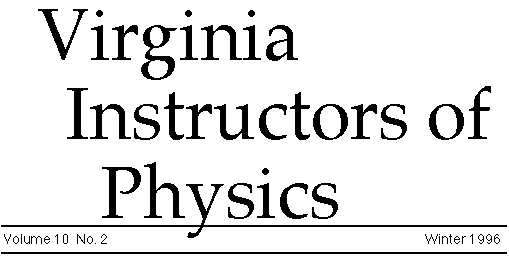
Last Fall's Meeting
by Tony Wayne
First order of business was the election of officers.
President: Tony Wayne
Vice-President: Andy Jackson
The question came up, "Who is VIP for? " VIP is for
teachers of physics and physical science in grades 7-up. The primary
focus of the group is in secondary education. Anyone can join. There
is no membership fee. To get on the mailing list, that's joining the
group, send a note via e-mail or US postal service to the president
of VIP, Tony Wayne. The newsletter comes out about 3 times a year
full of information relating to teaching physics and physical
science.
It was decided at this business meeting to strengthen our ties with
the Virginia Association of Science Teachers, VAST. This was tie
would be an inexpensive way to get the word out about who VIP is and
hopefully increase teacher involvement in the organization. By
affiliating with VAST we can and will put articles that appear in
these newsletters in the VAST newsletter with a reference to VIP. We
will also have notoriety on VAST web site. In accordance to this we
will have our fall 1996 meeting on November 10-11, at the VAST
conference at the Hotel Roanoke. To attend this conference you must
be a member of VAST. In an effort to keep VIP cheap, VIP will meet in
the spring at a University. This meeting will remain free and open to
everyone. It will probably be at the University of Virginia.
In an effort to get more involved in the education community a
committee was formed to investigate the possibility of creating a
Virginia Instructors of Physics Teacher of the year award. The
committee members are Andy Jackson, Craig Nunemaker, Tom O'Neil, and
Dr. Richard Lindgren. They are investigating possible award
sponsorships and what the application form and judging criteria may
look like. E-mail your questions/comments to them.
Andy Jackson volunteered to begin work on the question, "Why take
physics?" He is collecting information from universities and putting
in a format that can be distributed to all educators.
The afternoon consisted of a hands-on training session with the TI-82
Calculator Based Labs system. TI supplied us with 15 stations and 30
calculators. Thanks to Deborough Roudenbock for her presentation. It
was a very exciting afternoon for everyone. If you are interested in
a receiving the TI-82/CBL system as a loan for an inservice call TI
at (214) 917-6411. All but the call is free. They even pay for return
pickup at your school by Airborne Express!
Many thanks go out to Dr Deaver and the University of Virginia's
Physics Department for sponsoring not only the fall meeting but also
the cost of reproduction and mailing of this newsletter.
Spring 96 Meeting of VIP in conjunction with CSVAAPT
(CSVAAPT stands for Chesapeake Section of the Virginia American
Association of Physics Teachers)
Date: Saturday, April 13
Place: Miller Hall at James Madison University
9:00 - 9:15 Hellos
9:15 - 9:50 In Planetarium Intro Dean Garrison of the college of arts
and sciences and Mr Gordon
Background, history of, and goals of VIP
Background, history of, and goals of CSVAAPT
9:50 - 10:05 Business Session
10:05 - 11:00 Bring a Demo or Lab to show (75 copies to share)
11:00 - 12:30 Special Presentations (3 different presentations)
12:30 - 1:30 Lunch (You are on your own)
1:30 - 2:30 Discuss and Share session - Topic - "This really worked
well for physics day at Kings Dominion . . ." Share a success story
(and copies of how to reproduce it please)
2:30 Internet Intro
NOTE
For the "Special Presentations" the gathering will breakup into three
or more group, (depending on attendance), and have some
demonstrations of JMU's scanning electron microscope and the
tunnelling scanning electron microscope. There could be other events
as well. The details are still being finalized.
Mail the response form at the back of this newsletter or respond
via e-mail to asjackso@vapen.k12.va.us.
Please respond by April 6, 1996.
Monkey and the Hunter" Demo
Improvement
A suggestion by Andy Jackson
One of the classic projectile motion demonstrations is the "Monkey
and the Hunter" demonstration. This demonstration is one where a can,
the Monkey, is held to the ceiling by an electromagnet. The teacher,
the hunter, loads a projectile in a short pipe. The pipe is aimed up
at an angle at the can. The teacher propels the projectile with a
sharp breath. the the moment the projectile leaves the the pipe the
can is released. The projectile lands in the can. Okay, so I've left
out some details. Refer to the demonstration book by Carpenter and
Minnex for construction details. Andy's suggestion was to use a water
filled throw away plastic burette for the projectile. Fill the
burette with water. Then cut of the straw end close to the bulb.
Viola. A "safer" projectile.
Inertia demo
A demonstration by Jackie Hardy
Galileo's Law of Inertia states that a body at rest will remain at
rest and a body in motion will remain in motion until acted upon by
an outside force. To demonstrate the body at rest part you will need
a slip of paper, a piece of chalk and moistened finger.
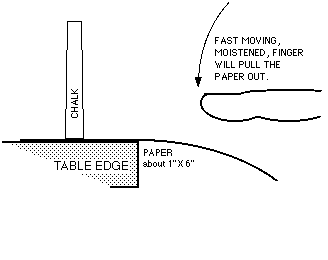
New Element
Discovered!
Submitted by Darren Watsky, Bayshore High School, Bradenton, FL
Some more humor to make the day go better courtesy of a student:
The heaviest element known to science was recently discovered by
university physicists. The new element, tentatively named
administratium, has no protons and no electrons, and thus has an
atomic number of 0. However, it does have one neutron, 15 assistant
neutrons, 70 vice-neutrons, and 161 assistant vice-neutrons. This
gives it an atomic mass of 247. These 247 particles are held together
by a force that involves a constant exchange of a special class of
particles called morons.
Since it does not have electrons, administratium is inert. However,
it can be detected chemically as it impedes every reaction it comes
in contact with. According to the discoverers, a minute amount of
administratium added to one reaction caused it to take over four days
to complete. Without the administratium, the reaction ordinarily
occurred in less than one second.
Administratium has a half-life of approximately three years, after
which it does not normally decay but instead undergoes a complex
nuclear process called "reorganization." In this little understood
process, assistant neutrons, vice-neutrons, and assistant
vice-neutrons appear to exchange places. Early results indicate that
the atomic mass actually increases after each "reorganization."
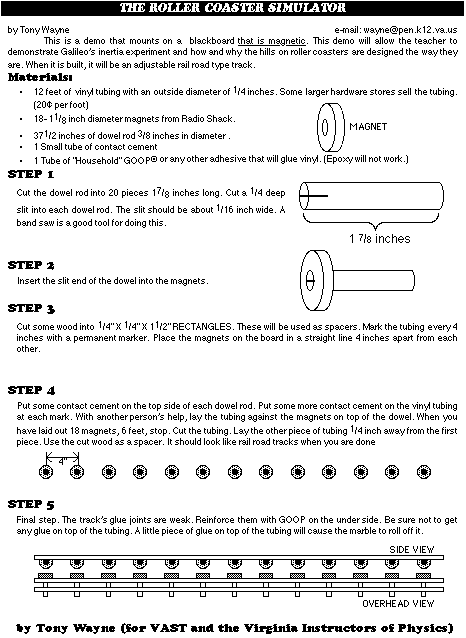
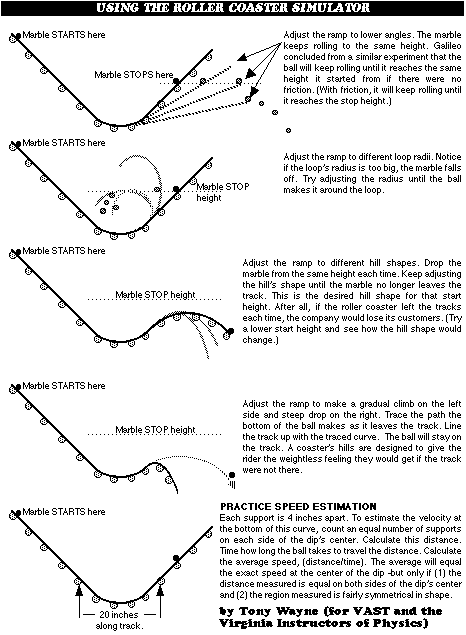

This quarter page makes a great sheet for students to carry with them
in the amusement park as a reminder of measurement techniques.
MEASURING THE VELOCITY OF A MOVING
OBJECT
In the classroom is a HotWheels set up. On this set up measure the
velocity of the HotWheels train as it passes over the second hill.
Treat this as a normal lab and repeat the process a number of times
and take the average of the trials.
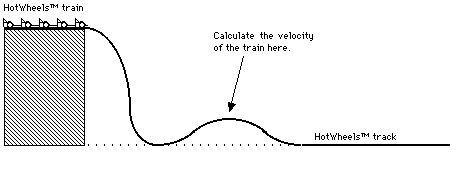
HotWheels train velocity: _____________
Note: It is also a good learning experience to adjust the hill so the
train does not leave the track when it passes over it. But to save
the train, it is more fragile than a car, have students adjust and
test the track with a single car. Then use the train for the
measurement of velocity. (The faster the train is traveling the
flatter the hill must become.)

by Tony Wayne
MATERIALS:
5 -Hot Wheels cars. (Use cars with a short front to back wheel
base.)
24 inches -Kevlar. (This can be found in most fishing goods
departments of larger stores with the fishing line.)
30 minute Epoxy
PROCEDURE:
1 Lay the cars upside down about 1/2 an inch apart from each
other.

2 Lay the Kevlar from front to back of the row of cars. Tape the
Kevlar in place with masking tape. Tape to the center of the car.

3 Mix and apply the epoxy over the kevlar and at each car's rivet.
The car's have two rivets under them. Let dry for at least 30
minutes. If the epoxy mix is not right, the car's may have to dry
longer.

4 To aide in seeing the center of mass of the train of cars, paint
the middle car. It is located at the center of mass.
Hot Wheels is a registered trademark of Mattel Inc.
THE "LOOP-THE-LOOP" LAB
SET UP-
Set up the lab poles as shown in figure 1. Tie a string to the top
cross bar. Make the string long enough so when a mass is attached to
the other end is almost reaches the table top. Give yourself a
centimeter or two clearance.
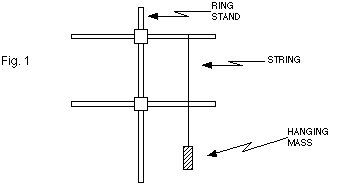
PROCEDURE-
You will hold the mass out the length of the string so the string is
parallel with the table top. When you release the mass it will "wrap
around" the lower cross bar and do a "Loop the Loop." We want to find
the critical position for the lower cross bar. In other words, the
mass just barely completes the loop around the lower bar while
keeping the string "straight" the whole way.

PRE-LAB QUESTIONS: COMPLETE PRIOR TO DOING THE LAB
1 The lower bar is at the "critical" position in figure 2. Shade in
the approximate range the lower bar can occupy and still have the
"loop the loop" occur.
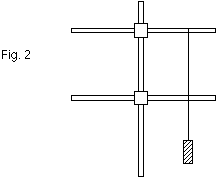
2 If you attach different masses on the string (making sure the total
length the string/mass stays constant) will the "critical" position
of the lower bar change?

Now do the experiment and find the critical position of the lower
bar. Once you have found it measure the height of the top bar, H, and
the height of the lower bar, h. It is important when measuring these
to use the center of the hanging mass as zero height and measure from
there. (See figure 3.) Now calculate the ratio of H/h and record it
here.
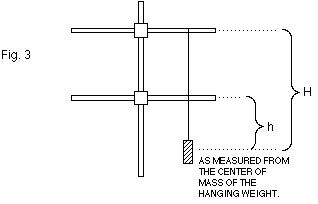
3 H/h = (numbers)
Now do experiment to find the answers to questions "1" and "2"
above.
POST LAB: SOLVE ALL OF THESE WITH SYMBOLS ONLY!
Make sure you differentiate between "H" and "h."
4 What minimum conditions must be met at the moment illustrated in
figure 4 for the loop to be completed?
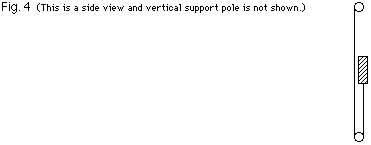
5 Use these minimum conditions to solve for the minimum speed at this
point.
6 What is the total energy of the mass at the moment illustrated in
figure 4? (Plug in the value of VMIN from above.)
7 When you hold the mass shown in figure 5 to start the lab, what is
the total energy?
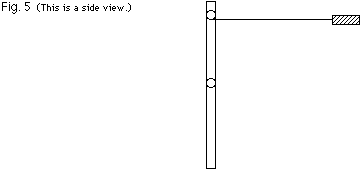
8 Using conservation of energy, solve for the ratio of the height of
the top cross bar to the height of the lower cross bar, H/h , (plug
in numbers at this point).
9 Calculate you relative error for this experiment.
10 Show the algebra line in the calculations that would reveal the
answer to the Pre-Lab question 2.
11 Explain why the lower bar may occupy any position below the
critical position and still "loop-the loop." PRE-LAB
1
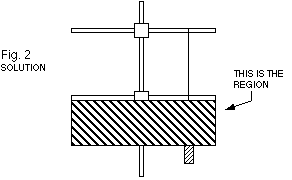
2 No, the bar's critical position will stay the same.
LAB
3 2.35
POST-LAB
4 Fc = mv2/r: where F is the centripetal force, m is the attached mass, v is the
velocity of the moving attached mass, and r is the
radius of the circle that the attached mass makes. Minimum conditions
would be that only the hanging mass provides the centripetal force
and the tension in the string is 0. so... mg = mv2/r. or using the
symbols introduced in this lab ...mg = mv2/h. This is because the
mass wraps around the bar. (The bar is the center so its heights is
the radius.)
5 Starting with mg = mv2/h the mass cancels out and you get . . .
g = v2/h. Multiply both sides by h and you get. . . gh = v2. Take the
square root of both sides and you get v = gh(1/2).
6 ETOTAL = EP + EK = mgh + (1/2)mv2 plugging in 2h for the height
and gh(1/2) for v gives mg(2h) + (1/2)mgh which simplifies
to 2.5mgh = ETOTAL.
7 ETOTAL = EP + EK but EK = 0. \ ETOTAL =mgh. The height in this
position is H. \ ETOTAL = mgH.
8 mgH = 2.5mgd. m and g divide out leaving H = 2.5h. \ H/h = 2.5.
9 Example calculation ->
10 Several different places could be used as examples. Anywhere mass
cancels out of the equation would be correct.
11 A mass at the top of the loop must have a certain minimum speed to
keep the string in a straight line. Less than this minimum speed and
the and the mass "falls out" of the circular path. If the bottom bar
is moved lower , the height at the top of the circle is less. This
causes the potential energy at the top of the loop to be less. This
means more energy is in the form of kinetic energy at the top. Thus
the mass is moving faster through the top of the loop than when the
bar was at the critical position.
SCIENCE DAY AT KING'S DOMINION IS COMING!
by Brion G. Patterson
VIP is again sponsoring Physics Field Day activities in conjunction
with Science Day at Paramount's Kings Dominion. Kings Dominion
expects to announce the exact date of Science Day by approximately
the middle of September. Brion Patterson is coordinating the Field
Day activities and welcomes your suggestion, by phone, e-mail or
snail mail.
EDITOR
Tony Wayne, Albemarle High School, 2775 Hydraulic Road,
Charlottesville, VA 22901
Internet e-mail:
PUBLISHED by
Dr. Bascom Deaver, Physics department, University of
Virginia, Charlottesville, VA 22901


|